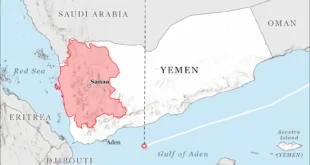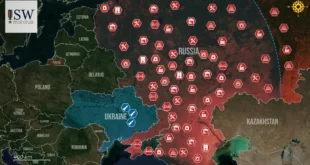Abstract: The October 7, 2023, Hamas attack on Israel triggered a rapid escalation in regional conflict and reshaped the operational landscape of Iran-backed violent non-state actors. Using data from the Global Terrorism Trends and Analysis Center’s GRID database, this article compares patterns of terrorist violence in the Middle East one year before and after the attack. The analyses reveal a dramatic rise in drone, rocket, and missile attacks—particularly by Hezbollah, the Houthis, and the Islamic Resistance in Iraq—against U.S., Israeli, and maritime targets. Despite the volume, these attacks caused limited casualties due to advanced U.S. and Israeli defenses, signaling a broader shift toward low-cost, high-frequency stand-off warfare, causing disruption over decisive outcomes. While Hezbollah and Hamas suffered major losses at the hands of Israeli forces, the Houthis emerged as Iran’s most active and disruptive proxy. The analysis underscores a post-October 7 reconfiguration of the proxy landscape and highlights the strategic limits of Iran’s indirect warfare and its eroded ability to deter direct Israeli attacks on Iran.
The October 7, 2023, Hamas attack on Israel was the deadliest assault in the country’s history, resulting in the deaths of about 1,200 people and the capture of 251 hostages.1 This shocking ‘black swan’ attack triggered a large-scale Israeli military campaign against Hamas in Gaza, which has led to over 54,000 Palestinian deaths (as of May 28, 2025)2 and an untold number of casualties. The campaign subsequently expanded into Lebanon, the West Bank, and Iran, further destabilizing the region. Recently, the Israel-Iran conflict has escalated into war, with Israeli airstrikes killing senior Iranian officials, triggering retaliatory missile and drone attacks, and causing casualties on both sides, raising fears of a prolonged and wider conflict.
While Israel has intensified its military operations against Hamas, Iran-backed groups escalated their attacks to show solidarity with Hamas. These groups have deployed unmanned aerial systems, rockets, and missiles in attempts to penetrate Israel’s aerial defense systems and strike Israeli targets. Additionally, they targeted U.S. military facilities using stand-off aerial weapons to avoid direct confrontations. The Houthis, Iran’s proxy in Yemen, have launched a series of drone attacks targeting Israel and both commercial and U.S. military vessels in the Red Sea and further expanded the regional scope of the conflict.
This article starts by providing an overview of the Global Terrorism Trends and Analysis Center’s Record of Incident Database (GRID), which forms the empirical basis of this article. Leveraging GRID data, the article then compares one-year periods before and after October 7 and examines the potential impact of the October 7 attack on the nature and frequency of terrorist attacks in the Middle East region. The mobilization and tactical evolution of Iran-backed groups (Hezbollah, the Houthis, Hamas, and the Islamic Resistance in Iraq) over the past year, with emphasis placed on their use of air-domain weapons such as drones, missiles, and rockets, is also explored. In addition, the article also evaluates the targeted operations of Iran-backed groups, the patterns and effectiveness of their attacks in achieving tactical objectives, the casualties inflicted, and the associated economic impact.
Part I: Introducing the GRID Database
The Global Terrorism Trends and Analysis Center (GTTAC) Record of Incident Database, commonly known as GRID, is a comprehensive open-source database that chronicles terrorist incidents around the world.3 This system was developed to gather and summarize data on terrorist events since 2018, primarily to support the Annex of Statistical Information on Terrorism, under contract with the U.S. Department of State’s Bureau of Counterterrorism. GTTAC is run jointly by the private research firm Development Services Group and the Terrorism, Transnational Crime & Corruption Center at George Mason University.
GRID utilizes open-source intelligence, gathered through multimedia data aggregators, to identify potential terrorist incidents.a The database employs ontologies for various aspects of terrorism, including incidents, perpetrators, tactics, weaponry, and victim/facility targeting.4 After automated processing and triage, a team of multilingual subject-matter experts, technologists, and researchers reviews and validates the information before entering it into GRID.
To ensure accuracy and objectivity, GRID only includes incidents reported by independent and reliable sources, excluding information from terrorist media or incidents with significant uncertainty. This uncertainty, which is widespread in many areas around the world, is often present in open-source reporting on terrorism incidents. Being dependent on open-source reporting means that GRID is vulnerable to disruptions in journalistic reporting and standards around the world. GTTAC aims to mitigate these challenges by developing a roster of regionally focused analysts with continuously updated methodologies that are specific to not only the terrorism that is present in those regions, but also the reporting standards, quality, and sources for specific countries. Finally, the definition of terrorism that is utilized for GRID means that it is restricted in its reach, and the trends reported are not the full reflection of political violence experienced around the world. The GRID dataset is dynamic, with updates typically occurring weekly. This report uses GRID data retrieved on January 15, 2025.
Part II: Evaluating Regional Terror Activity Pre- and Post-October 7
Incident Trends
The October 7, 2023, Hamas attack was a pivotal moment, leading to an immediate surge in violent activity across the Middle East. During the year prior to October 7, there was a relatively steady increase in the number of incidents and fatalities, peaking occasionally but generally maintaining a lower level of intensity compared with terror activity one year after the attack. The attack led to an immediate and dramatic rise in fatalities, followed by a sustained period of heightened activity. While fatalities declined from their peak on October 7, incidents remained consistently high, indicating a shift toward more frequent non-state terror violence. Figure 1 illustrates trends of terrorist attacks in the Middle East, which indicates a significant shift in terrorism targeting patterns, with increased attacks on Israel and U.S. assets in the region in the year following October 7.
Following the October 7 attack and Israel’s intensified military response in Gaza, Iran’s support and influence—as a key backer of Hezbollah and Hamas—have become more visible.5 Maintaining substantial leverage over its network of proxies, Iran reinforced a unified “Axis of Resistance” formed by Iran-backed groups acting in solidarity with Hamas, targeting both Israel and U.S. assets in the region. Hezbollah emerged as the group that perpetrated the most attacks, with a sharp increase to 1,398 incidents from only three incidents with no recorded fatalities during the year prior to October 7. (See Figure 1.) This sharp increase reflects another chapter in the episodic nature of Hezbollah’s violent campaigns against Israel.6 Hamas had been relatively inactive in the year before its October 7 assault, with only 39 recorded incidents—possibly reflecting strategic restraint in the lead-up to a major operation. Following the attack, as the group engaged in direct conflict with Israel in Gaza, its recorded violent attacks surged to 480 incidents, yet the Israeli counteroffensive degraded Hamas’ military infrastructure and leadership in Gaza and limited its operational capacity.
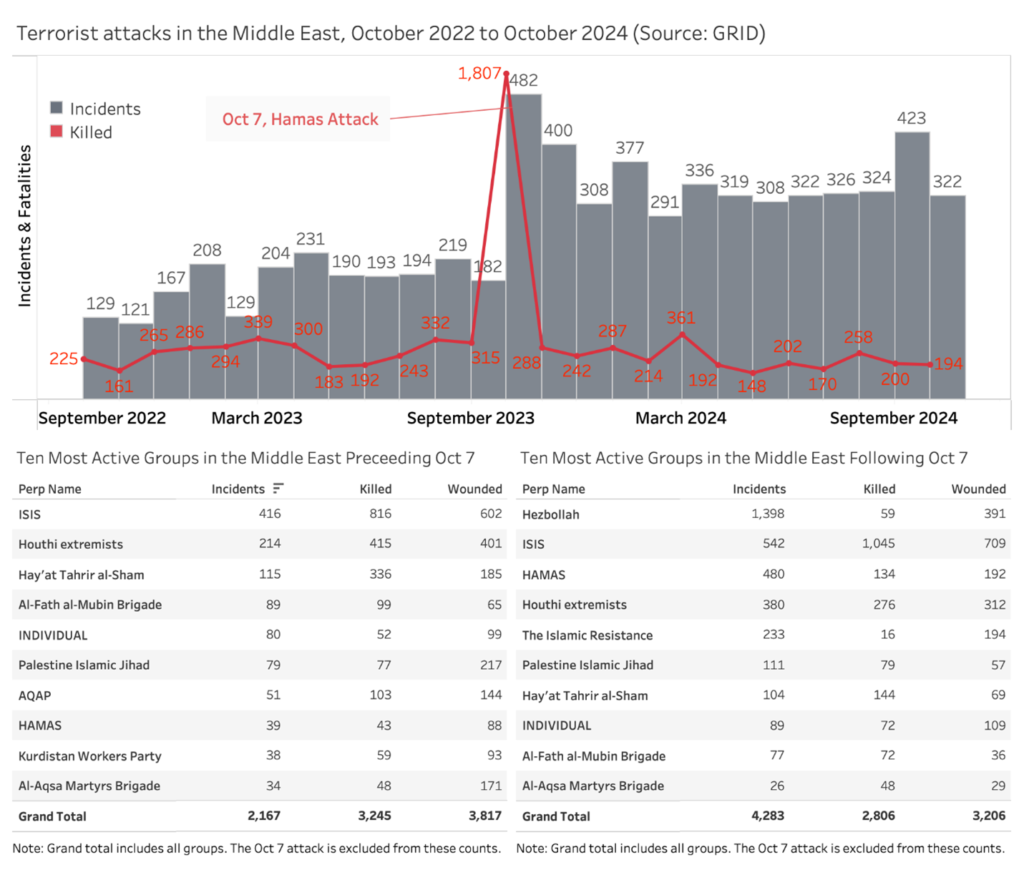
Another Iran-backed group, the Houthi movement, declared war on Israel on October 31, 2023, as a reaction to Israel’s military campaign in Gaza and in support of Hamas.7 The Houthis began launching drone attacks against Israel, demonstrating their growing stand-off strike capabilities.8 In November 2023, the Houthis also declared their intention to attack Israeli-linked shipping.9 This led to a series of attacks on shipping in the Red Sea, significantly disrupting global maritime trade, and expanded to include assaults on commercial and naval ships.10 According to the Pentagon, about 190 such attacks were recorded from November 2023 to June 2024.11 As reported by the Defense Intelligence Agency, by March 2024, the Houthi attacks had affected ships linked to more than 65 countries, illustrating the global nature of the threat.12 For the year after October 7, the Houthis’ violent activity escalated to 380 incidents, reflecting a broader regional response to the conflict between Israel and Hamas. Of these, 84 attacks were intended to target U.S. military bases or navy vessels in the region; however, none were successfully executed against U.S. targets.
The Islamic Resistance in Iraq (IRI) emerged after October 7 as an umbrella organization for Iran-backed Iraqi militia groups supporting Hamas in its armed struggle against Israel.13 IRI unites several groups designated by the U.S. State Department as Foreign Terrorist Organizations, such as Kata’ib Hezbollah, and Specially Designated Global Terrorists, including Harakat Hezbollah al-Nujaba, Kataib Sayyid al-Shuhada, and Ansar Allah al-Awfiya.14 GRID data indicates that IRI carried out 233 attacks in the year following October 7, which resulted in 16 deaths. Of these, 194 attacks were intended to target U.S. military forces in the region. Only 14 of these attacks were effectively carried out and hit intended targets, leading to 74 U.S. service members reported wounded.
Beyond Iran’s proxy groups, other terrorist organizations, particularly the Islamic State, have also contributed significantly to the region’s volatile security environment. The Islamic State in Iraq and Syria was the most active network in the region before October 7, responsible for 416 incidents in the preceding year. Its violent activities were concentrated primarily in Syria, and to a lesser extent in Iraq. The Islamic State’s violent campaign in Iraq and Syria increased to 542 incidents in the year following October 7. While the Islamic State did not specifically target Israel or Jewish populations, it has framed its violent campaigns in Syria, Iraq, and other regions as contributions to the Palestinian cause and part of a broader fight against regimes protecting Israel.15
Overall, the operational focus of the Islamic State’s network in the Levant remained largely unchanged, continuing to prioritize its anti-Shi`a narratives and takfiri ideology rather than shifting toward a Palestine-centric jihad. For example, in January 2024, Islamic State Khorasan carried out one of the deadliest attacks in Iran’s history, bombing a ceremony in Kerman that killed more than 80 people.16
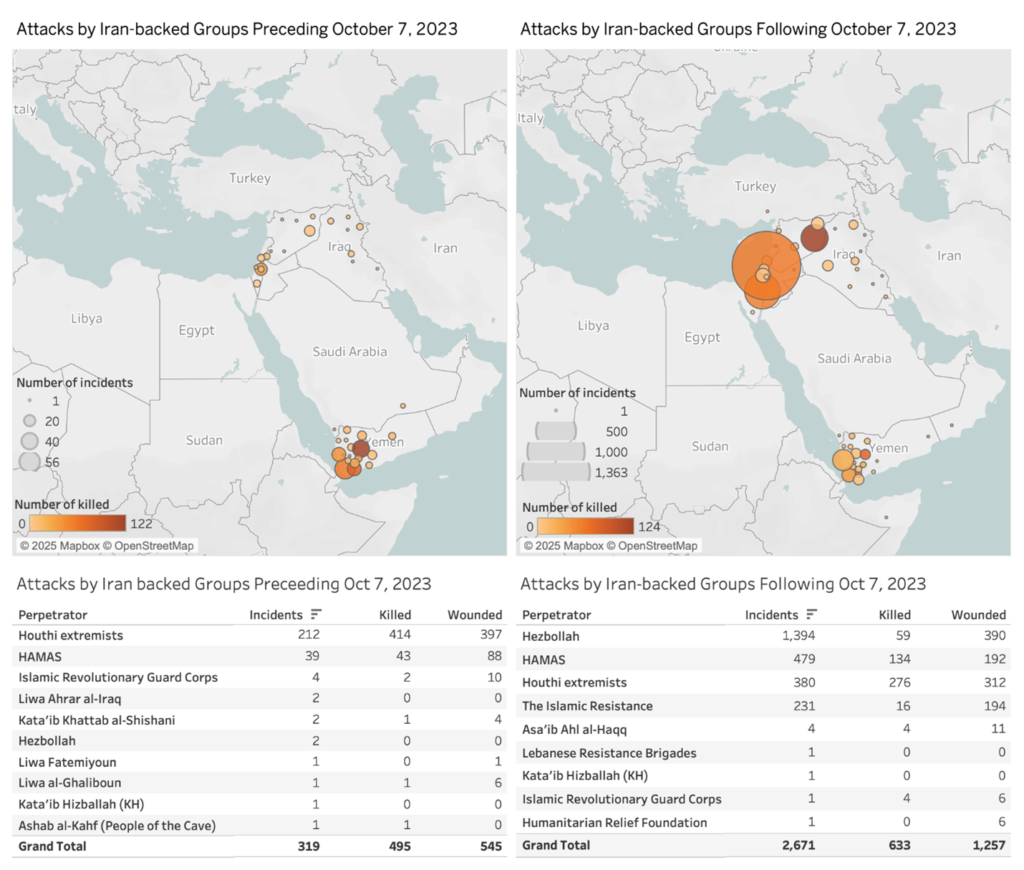
Geographic Dynamics
The October 7 Hamas attack served as a catalytic event that not only changed the intensity but also dramatically reshaped the geographic distribution of terrorist violence across the Middle East. (See Figure 3.) During the year prior to October 7, non-state terror violence in the Middle East region was concentrated primarily in Syria (1,180 incidents), Yemen (336 incidents), and the West Bank (308 incidents). The intensity of violence is reflected in Syria, which experienced the highest fatalities (2,109) and injuries (1,848). After October 7, 2023, the focal point of attacks shifted significantly, with Israel experiencing the largest surge in incidents (1,999). Yet, despite the highest number of non-state terror attacks being against Israel, the number of fatalities remained low, at 173.
Syria remained a major hotspot the year after October 7, with 1,288 incidents and 1,675 fatalities recorded for that year. These incidents were largely driven by internal dynamics and civil conflict within Syria rather than direct involvement in the Israel-Hamas war. As the Houthis focused more on Israel, U.S. naval vessels, and commercial vessels in the Red Sea and the Gulf of Aden following the October 7 attack, Yemen saw an increase in overall incidents (rising from 336 to 432) with a significant surge in attacks against maritime, commercial, and naval vessels, which rose from two to 162. Yemen remained one of the top countries in the region experiencing non-state terror violence. As seen in Figure 3, the October 7 attack significantly shifted preexisting trends and demonstrates how a high-impact, black-swan terror event can trigger immediate escalations in other countries and further destabilize a region.

UAS, Missile, and Rocket Attacks
Analysis of GRID data reveals a clear shift in the scale, scope, and nature of attacks in the region. Unmanned aerial systems (UAS) and rocket attacks have become central tools in the arsenals of Iran-backed actors. What had been infrequent and geographically limited strikes escalated into high-volume, cross-border campaigns targeting primarily U.S. and Israeli positions and assets in the aftermath of October 7.
UAS
According to GRID data, UAS attacks by non-state actors were relatively infrequent and localized in the Middle East, with a total of 59 UAS recorded incidents in the region in the year preceding October 7. Key perpetrators were primarily Houthis in Yemen, responsible for 29 incidents that caused 37 deaths and 34 injuries. Other groups, such as al-Qa`ida in the Arabian Peninsula (AQAP), conducted limited operations with minimal casualties. The primary geographic focal points of UAS attacks during the year prior to October 7 were concentrated in Yemen, Syria, and Iraq, with Yemen accounting for the highest number of incidents (31) and significant casualties (28 deaths) from UAS attacks. (See Figure 4.)

A sharp escalation in the use of UAS attacks was observed throughout the region after October 7, with a total of 417 incidents recorded over the year. (See Figure 5.) Hezbollah emerged as the most active perpetrator of UAS attacks (146 incidents), followed by the IRI (127 incidents), and the Houthis (96 incidents).
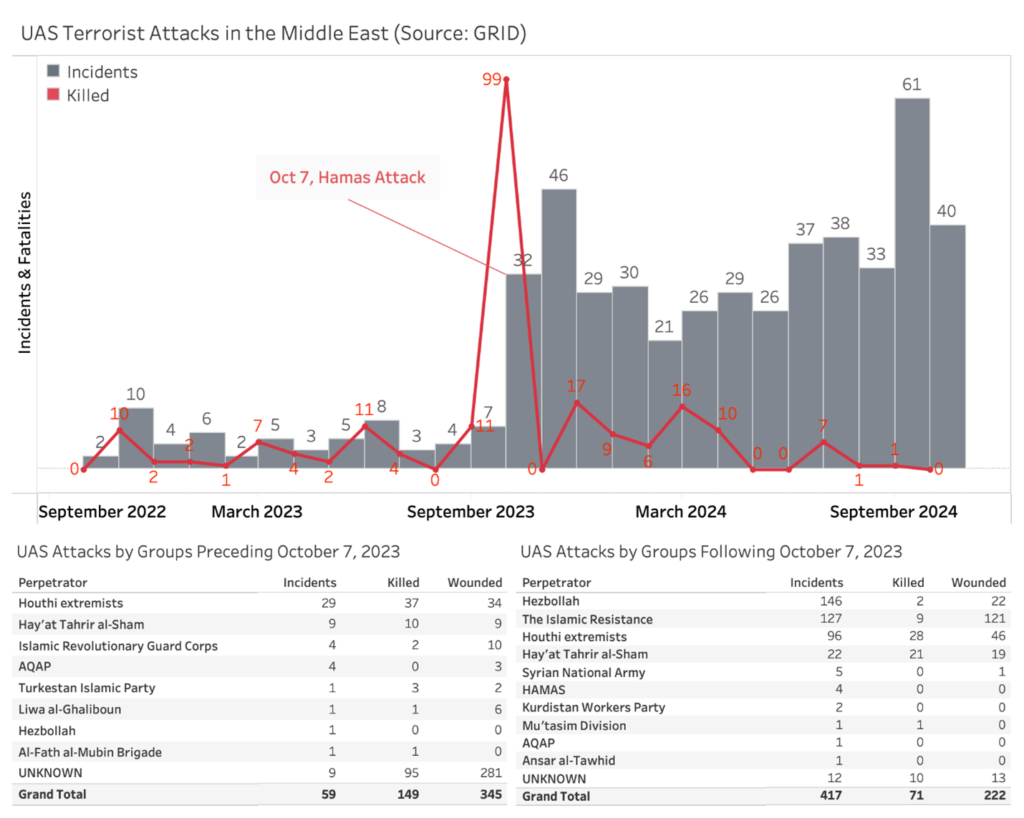
Additional analysis of GRID data revealed that this surge was accompanied by a significant geographic expansion and target diversification of UAS activity after October 7 by non-state terror actors. While UAS attacks mainly targeted regional governments and local adversaries (e.g., Saudi Arabia and Yemeni government forces) before October 7, the focus shifted to international targets, especially U.S. military bases in Iraq and Syria and Israeli targets. For example, Israel, which had experienced only a single UAS attack in the year prior, endured 174 incidents post-October 7. GRID recorded 106 UAS attacks in Syria in the year after October 7, 70 of which intended to target U.S. military assets based in Syria. According to GRID data, of these, seven hit the target and led to a total of 49 injuries of U.S. service members. Ninety UAS incidents took place in Yemen (89 of them executed by Houthis and one by AQAP), 52 of which were aimed at U.S. military and naval vessels, though none of them successfully hit their intended targets. In Iraq, 34 UAS attacks occurred, 30 of which were executed by the IRI. All these targeted U.S. military assets, with three of these attacks successfully hitting the target and resulted in injuries to seven U.S. service members (no fatalities).
Overall, according to GRID data, during the year after October 7, Iran-backed groups conducted 373 UAS attacks, 153 of which were intended to strike U.S. military targets, up from just one incident recorded by GRID during the year prior to October 7. The IRI alone accounted for 100 intended attacks against U.S. military; 11 of these incidents were able to hit the target. The deadliest incident during this period occurred on January 28, 2024, when the IRI launched a drone strike on Tower 22, a U.S. military base located in northeastern Jordan near the Syrian border. The attack killed three U.S. soldiers and injured 47 service members—the highest number of casualties from a UAS attack on U.S. forces during this timeframe. Houthis executed 96 UAS attacks, 53 of which were intended to target U.S. assets, compared to none targeting U.S. assets in the prior year according to GRID data.
GRID also recorded 26 intended UAS attacks on non-U.S. foreign military assets in the year after October 7, including U.K., French, and Israeli naval vessels in the Red Sea and Gulf of Aden, with the Houthis responsible for nearly all, which is a stark rise from zero the year prior to October 7.
Overall, the Houthis have significantly expanded their operational reach through UAS and stand-off attacks. Prior to October 7, however, the Houthis conducted UAS strikes on critical infrastructure in Saudi Arabia and the United Arab Emirates, which spearheaded the Saudi-led coalition against Houthis in the Yemen war. In the aftermath of October 7, the Houthis intensified their assaults on international commercial and naval vessels, and, more recently, direct attacks against Israel. They carried out seven UAS attacks directly targeting Israeli territory in the year following the October 7 attack. In one such incident on July 19, 2024, a Samad-3 drone—which is reportedly capable of carrying an explosive payload over a range of 1,500 kilometers17—struck Tel Aviv, killing one Israeli civilian, injuring at least 10 others, and causing material damage to property and vehicles.18 With Iranian support,19 the Houthis’ rapid adoption of UAS technology has enabled them to internationalize the conflict and carry out long-range strikes with more precision.20
Missiles and Rockets
The proliferation of Iran-backed groups’ tactics extends beyond UAS attacks to include a significant increase in missile use. As seen in Figure 6, GRID reveals a dramatic spike in rocket artilleryb attacks after October 7. The recorded rocket artillery attacks increased from 168 one year prior to October 7 to 1,394 one year after October 7, revealing an over-eightfold increase. For example, Hezbollah was responsible for 749 incidents, accounting for more than 50 percent of rocket artillery attacks in the Middle East during the year after October 7, compared with negligible activity the year prior. While this reflects a dramatic escalation over the two-year span, Hezbollah’s violent campaigns, including missiles and rockets, have historically been episodic, with prior periods of intense activity, most notably during the 2006 war. The most prominent groups exhibiting increased rocket artillery attacks the year after October 7—Hezbollah, Hamas, Palestinian Islamic Jihad (PIJ), and the IRI—are all Iran backed. Hamas, for instance, increased its rocket attacks from 14 incidents the year before October 7 to 401 incidents the year after. Similarly, PIJ expanded its operations from 24 incidents the year before October 7 to 74 incidents the year following. The IRI conducted 69 rocket artillery attacks during the same post-October 7 period.
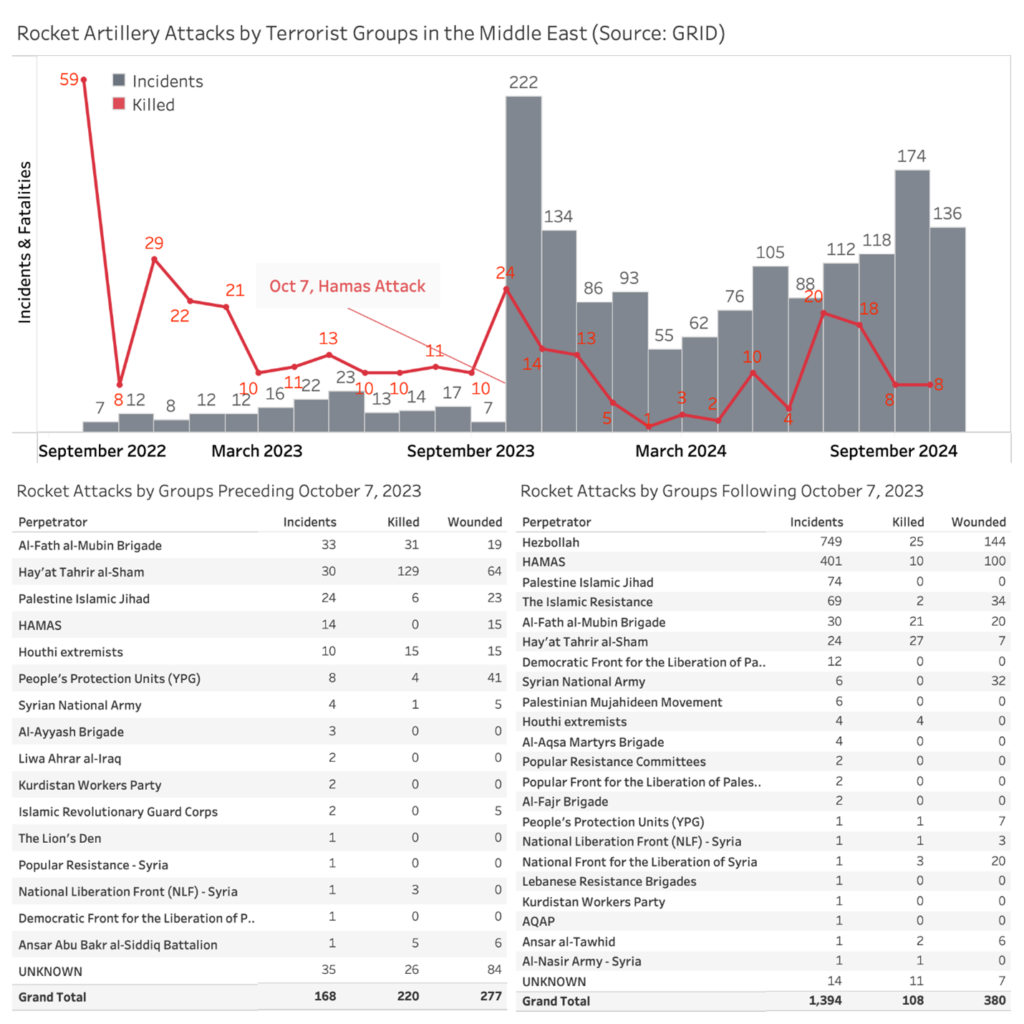
The geographic scope of these types of attacks also widened significantly. (See Figure 7.) The year prior to October 7, rocket attacks were largely localized in Syria, Israel, Yemen, and the Gaza Strip. The year after, regional activity intensified, particularly in and around Israel and Syria. Notably, Israel became the primary target the year after October 7, with incidents surging from 33 the year prior to October 7 to 1,227 the year after, signaling a major escalation in both frequency and strategic focus, which many observers have noted. On the other hand, according to GRID data, the Houthis’ use of rockets and missiles during this period decreased from 10 incidents in the year before October 7 to four in the year after. This is a continuation of the Houthis’ declining trend in using rocket missiles, primarily due to the depletion of their pre-war unguided rocket stockpile and a strategic shift toward guided missiles and drone technology.21
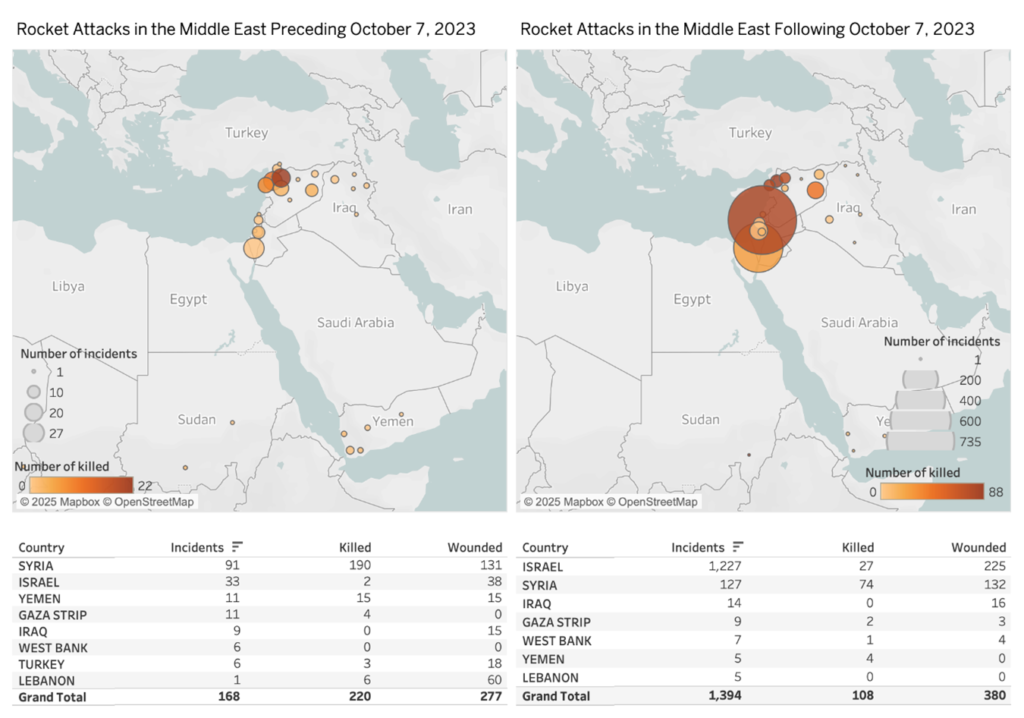
Lethality
The authors’ analysis reveals a notable trend: Although the number of terrorist attacks across the Middle East surged significantly after October 7, the number of fatalities remained relatively stable, excluding the October 7 Hamas attack, which represents a black swan outlier. For example, incidents rose from 182 attacks in September 2023 to 484 attacks in October 2023, marking a nearly twofold increase over a two-month period. Despite this surge, fatalities did not rise correspondingly; the number of deaths fluctuated around the same levels as before the attack on October 7.
When comparing Iran-backed groups with other organizations such as the Islamic State, one of the most significant differences lies in the fatality rate per attack. The fatality rate for Islamic State attacks in the Middle East for the period under consideration stands at 1.93 deaths per attack, meaning nearly two fatalities per incident on average. Broadening the scope, non-Iran-backed groups worldwide conducted 12,153 terror attacks over the two-year period, resulting in 39,282 fatalities—an average of 3.23 deaths per attack.
In stark contrast, Hezbollah attacks during the same period resulted in just 0.042 deaths per incident—approximately 45 times lower than the Islamic State’s rate and 75 times lower than that of non-Iran-backed groups. Other Iran-backed groups also showed notably low fatality rates, including the IRI (0.07) and the Houthis (1.16). Excluding the October 7 attack, Hamas’ fatality rate averaged 0.32 over the two-year period; it dropped from 1.10 before the attack to 0.28 afterward.
Several factors could explain this finding. One primary explanation is that the increased use of missiles, rockets, and UAS tactics by Iran-backed groups have targeted U.S. military installations in the region and Israel. These aerial-borne attacks were mostly neutralized by advanced air defense systems. For instance, during Iran’s large-scale attack on Israel in April 2024, in which more than 300 drones and missiles were launched at Israel, the Israel Defense Forces claimed that 99 percent of the projectiles were successfully intercepted.22
Data from GRID also speaks to this. For example, a significant decline in fatalities from UAS and rocket attacks launched by Iran-backed groups following October 7 was observed in the dataset. The average fatality rate for drone attacks from these entities dropped from 2.53 deaths per attack during the year prior to October 7 to 0.17 the year after that attack, which is a 93 percent decrease. In a similar vein, the fatality rate of rocket attacks dropped from 1.31 deaths per attack during the year before October 7 to just 0.08 the year afterward, marking a 94 percent reduction.
While these attacks resulted in limited casualties, they were still effective in imposing economic costs—especially given the imbalance between the relatively low cost of drones and rockets and the high expense of counter-UAS technologies and air defense systems.23
Conclusion
The October 7 attack marked a turning point in regional security and triggered widespread escalations by Iran-backed groups. Data and analysis featured in this article reveal a shift in the geographic distribution and tactical evolution of non-state terror violence in the region in the year that followed the attack. While terrorist incidents surged, particularly in Israel and the Red Sea, fatality rates remained disproportionately low. This paradox appears to be due largely to the reliance on mostly rudimentary unmanned aerial systems24 and rocket attacks. Despite their ability to bypass conventional defenses, these attacks were also largely neutralized by Israel’s and the United States’ counter UAS and advanced air defense systems.25
The fatality rate for Iran-backed groups remains significantly lower than those of organizations such as the Islamic State, which continue to prioritize close-quarters assaults, bombings, and suicide attacks over aerial strikes. The evidence suggests that while proxies such as Hezbollah, the Houthis, and the IRI have expanded their operational reach and intensified attacks, they have struggled to achieve their strategic objectives. Their reliance on stand-off warfare has disrupted regional stability and global trade and instilled fear among large civilian populations, but it has proven ineffective in causing mass casualties. Instead, their actions have escalated economic and military costs for targeted states, particularly Israel and the United States. These findings underscore the evolving nature of non-state violence, particularly among Iran-backed groups, where proliferation of UAS shapes non-state strategies but remains constrained by superior—though disproportionately more expensive26—countermeasures from state actors.
Looking beyond October 2024, into the second year after the October 7 attack, Iran’s Axis of Resistance—its network of state and non-state allies across the Middle East—has suffered significant setbacks,27 and Iran’s ability to shape regional dynamics through non-state actors has been significantly constrained. Israel’s counteroffensive and intelligence operations have eliminated Hezbollah’s high command and many of its members, while inflicting severe damage on its forces and weapons stockpiles. A further blow to Hezbollah came with the collapse of the Assad regime in Syria in December 2024, severing a crucial land corridor that had long facilitated Iranian support to Hezbollah in Lebanon. Hamas also has been severely weakened. Israel’s invasion and bombing of Gaza have devastated Hamas’ military infrastructure, manpower, underground tunnel networks, and weapons arsenal as well as decapitated its leadership by eliminating its key figures. Meanwhile, amid these setbacks, the Houthis have emerged as Iran’s most formidable proxy,28 aggressively disrupting maritime trade in the Red Sea. Yet, the direct exchange of strikes between Israel and Iran in June 2025 has introduced a new and potentially far more volatile phase, shifting the conflict from proxy warfare to direct state-on-state confrontation with uncertain future implications.
Overall, the October 7 attack and Israel’s sweeping military response redrew the map of regional conflict, triggering a wave of proxy escalations, transforming the operational playbook of violent non-state actors in the region, and escalating into a direct Israel-Iran war in June 2025. The GRID data reveals a sharp surge in attacks—particularly by Iran-backed groups using drones, rockets, and missiles—but these assaults, though disruptive, produced limited casualties due to capable U.S. and Israeli defenses. This shift marks a pivot toward stand-off terror warfare: cheaper, remote, and high-volume, yet strategically ineffective in achieving decisive outcomes.
 Eurasia Press & News
Eurasia Press & News


